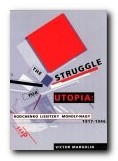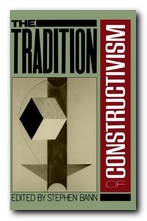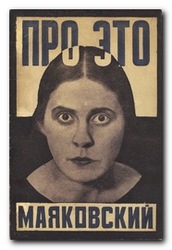Rodchenko, Lissitzky, Moholy-Nagy 1917-1946
This is a series of essays tracing the development of three ground-breaking artists who deliberately harnessed their design skills during the highpoint of modernism to the service of revolutionary social change. The first chapter of The Struggle for Utopia offers an analysis of Alexander Rodchenko‘s designs for public information kiosks, comparing them with El Lissitzky‘s for new forms of paintings and books. This points to the essentially conservative ideology underlying some of Rodchenko’s work, in distinction to El Lissitzky’s attempts to break into new ground. The next deals with the work and theories of the German constructivists – Moholy-Nagy and Lissitzky who had moved to Berlin from the Soviet Union.
 There were lots of theoretical wranglings amongst the artists and many bold claims made for the social and even revolutionary meanings in their works. Nevertheless, a simple connection between artist’s belief or intention and its manifestation on canvas or print remains as illusive as ever it will be. And if these abstract paintings dropped out of the sky unsigned, their meanings would be even more intractable.
There were lots of theoretical wranglings amongst the artists and many bold claims made for the social and even revolutionary meanings in their works. Nevertheless, a simple connection between artist’s belief or intention and its manifestation on canvas or print remains as illusive as ever it will be. And if these abstract paintings dropped out of the sky unsigned, their meanings would be even more intractable.
This is followed by a chapter on Rodchenko’s work between 1922 and1927 when he gave all his creative energy to the cause of ‘production art’ – the design of socially useful objects such as furniture, books, magazines, exhibitions, and advertising posters. His furniture was never put into production [through no fault of his own] but his graphic design was a big success, was hugely influential, and is still fresh as paint today.
Next comes a comparison of the pioneering work in photography done by Rodchenko and Moholy-Nagy in the 1920s. Then Margolin tackles the difficult task of trying to find positive things to say about the work Rodchenko and Lissitzky produced as propagandists during the black years of the Stalin period. He does his best, but it’s difficult to take seriously the pictures of smiling ethnic minorites and the construction of the White Sea Canal when we now know the brutal truth of what was going on.
Rodchenko amazingly survived until 1956, though he produced nothing more worthy of note. Moholy-Nagy moved to Chicago where he influenced a whole generation of product desgners in his new Bauhaus Institute of Design.
This is a scholarly work with a full apparatus of citations, references and footnotes. It’s also beautifully designed, illustrated, and printed – as befits the subject matter. My only carp is that I wish a list of further reading had been extracted from the dense thicket of footnotes which cluster at the bottom of almost every page of the book. I want to read more: make it easy for me to follow up.
© Roy Johnson 2000
Victor Margolin, The Struggle for Utopia: Rodchenko, Lissitzky, Moholy-Nagy 1917—1946, Chicago: University of Chicago Press, 1997, pp.259, ISBN: 0226505162
More on design
More on media
More on web design

 However, it should perhaps be remembered that many visual artists, from art-college onwards, come badly unstuck when it comes to expressing their ideas in words. That’s why theories of constructivism and any other movement should be founded on what is produced, not what is said. This is one of the weaknesses of extrapolating aesthetic theories from documents such as those reproduced here. Much huffing and puffing can be expended on whatever artists said about their art, rather than what they produced. But these are theories based on opinions rather than material practice.
However, it should perhaps be remembered that many visual artists, from art-college onwards, come badly unstuck when it comes to expressing their ideas in words. That’s why theories of constructivism and any other movement should be founded on what is produced, not what is said. This is one of the weaknesses of extrapolating aesthetic theories from documents such as those reproduced here. Much huffing and puffing can be expended on whatever artists said about their art, rather than what they produced. But these are theories based on opinions rather than material practice. Taking a sympathetic attitude to the early efforts of these artists to develop a revolutionary approach to art, it’s interesting to note that they thought subjective individual expression ought to be replaced by collective works. They also fondly imagined that the working class would unerringly prefer the most imaginative and original works over traditional offerings. This was a period in which the term ‘easel painting’ was used in a tone of sneering contempt. The fact that they were largely ignored by the class for whom they thought they were fighting this aesthetic war in no way diminishes their achievements.
Taking a sympathetic attitude to the early efforts of these artists to develop a revolutionary approach to art, it’s interesting to note that they thought subjective individual expression ought to be replaced by collective works. They also fondly imagined that the working class would unerringly prefer the most imaginative and original works over traditional offerings. This was a period in which the term ‘easel painting’ was used in a tone of sneering contempt. The fact that they were largely ignored by the class for whom they thought they were fighting this aesthetic war in no way diminishes their achievements.